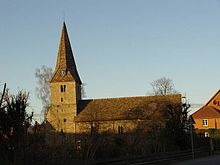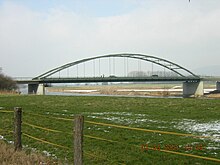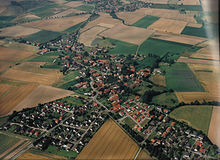Feel
|
Feel
City of Hessisch Oldendorf
|
|
|---|---|
| Coordinates: 52 ° 9 ′ 6 ″ N , 9 ° 14 ′ 26 ″ E | |
| Height : | 63 (60-64) m |
| Area : | 4.23 km² |
| Residents : | 800 |
| Population density : | 189 inhabitants / km² |
| Incorporation : | 1st January 1973 |
| Incorporated into: | Hemeringen |
| Postal code : | 31840 |
| Area code : | 05152 |
Fuhlen is a district of Hessisch Oldendorf on the Weser in the Hameln-Pyrmont district in Lower Saxony .
history
Creation of feelings
Fuhlen was first mentioned in a document in 1146. Stone Age settlement remains in the Fuhler district suggest a long history. The Fuhler Kernhöfe originated in the time of the Saxon heyday before 800 AD. The historical core of the old village directly on the edge of the old flood plain was probably on a central place, on which church and parish were laid out, around which the courtyards are then grouped. The St. John the Baptist Church was probably built in the 2nd half of the 12th century in the Romanesque style. Fuhlen was reformed on August 24, 1559.
Feeling through the ages
In 1550, 34 families with around 240 inhabitants lived in Fuhlen. There was a lively exchange of goods with the neighboring Hessisch Oldendorf. In the course of the Thirty Years War Fuhlen became impoverished due to various billeting . In 1795 the first census in Fuhlen showed 414 inhabitants. Until the beginning of the Second World War , the population of Fuhlens fluctuated between 400 and 500. Due to the immigration of displaced persons , the population of Fuhlens jumped to 900 after the Second World War.
Fuhlen was a mainly agricultural village. Around 1950 there were 25 companies in Fuhlen. The only bigger one was the brickworks , the others were mainly businesses closely linked to agriculture (e.g. blacksmith, wheelwright, miller). In addition to its rural population, Fuhlen developed into a workers' and residential community.
The Fuhler Weser Bridge
Fuhlen was connected to Hessisch Oldendorf by two bridges mentioned in 1407. Around 1643, the medieval bridges were destroyed by a flood and replaced by a ferry . Because the ferry was no longer able to cope with the volume of traffic, it was replaced in 1898 by the chain suspension bridge that had previously been demolished in Hameln. In April 1945 the bridge was blown up by German pioneers, in 1953 the Weser Bridge, which still exists today, was inaugurated, which is currently being dismantled. Since the summer of 2018, the town has had a modern bridge that corresponds to the traffic volume.
From the community to the district
On January 1, 1973, Fuhlen was incorporated into the Hemeringen community . Hemeringen was incorporated into the city of Hessisch Oldendorf on January 29, 1973 .
Feel today
Today Fuhlen has around 800 inhabitants. The Agriculture no longer plays in Fuhlen livelihood a role. There are a number of small local businesses. The majority work outside. In 1995 the "Dornenpark" settlement was built to close the village between Brüggenanger and Kerndorf. After the bypass road has been built, the Fuhlen thoroughfare will be dismantled and renewed. In the course of the village renewal, the "Dieter-Grabbe-Platz" with a village well was built in 2007. The annual highlight is the fair that has been held since the Reformation and takes place on the last weekend in August.
Local associations
- Village renewal working group
- Fuhlen village community
- Volunteer firefighter
- Fun fair association Fuhlen
- Warrior companionship
- Trumpet choir of the Protestant parish
- Riding and driving club
- Flößer Sonnental
- TSV Fuhlen eV
literature
- Friedrich Kölling, Walter Maack: Fuhlen - contributions to the history of the village . Rinteln 1959
Individual evidence
- ^ Federal Statistical Office (ed.): Historical municipality directory for the Federal Republic of Germany. Name, border and key number changes in municipalities, counties and administrative districts from May 27, 1970 to December 31, 1982 . W. Kohlhammer GmbH, Stuttgart and Mainz 1983, ISBN 3-17-003263-1 , p. 195 .




